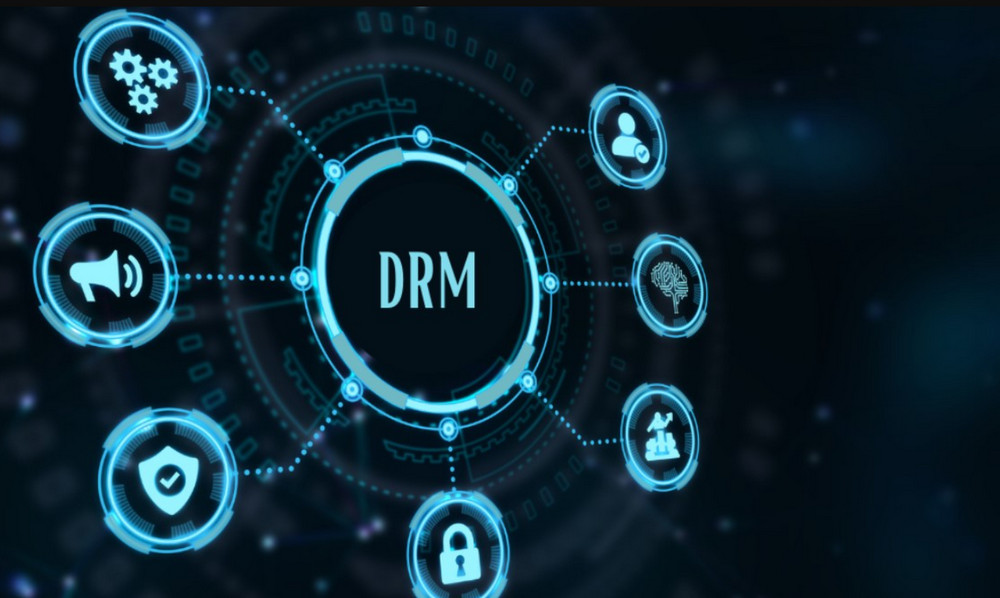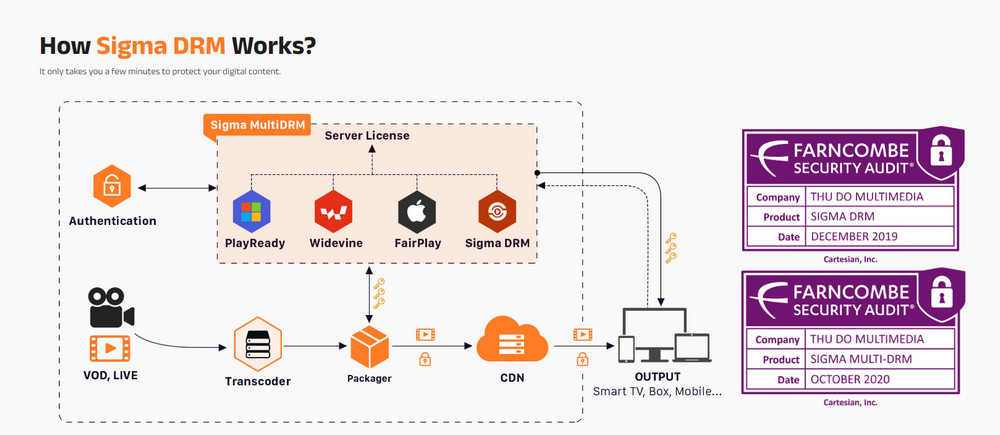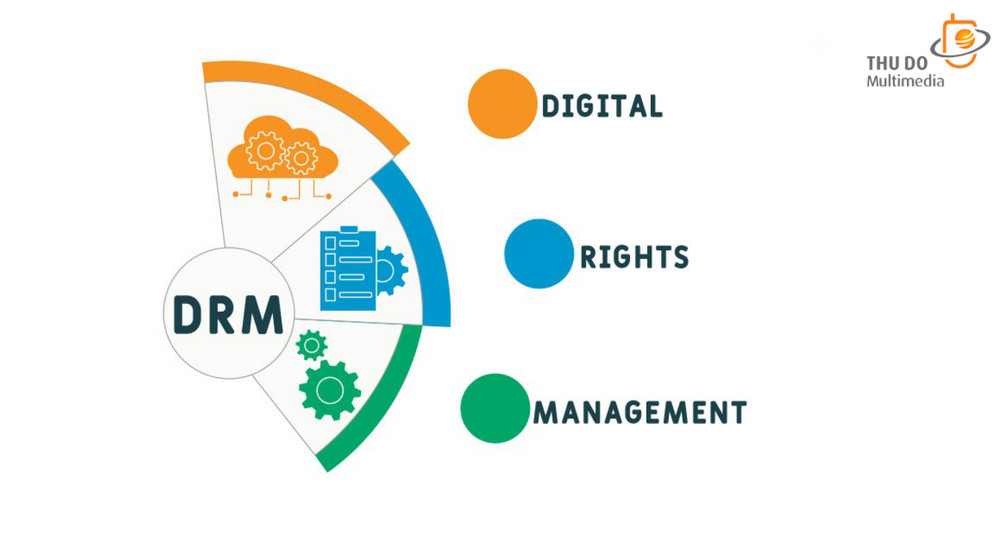Content providers employ Digital Rights Management (DRM) as a strategy to regulate the usage and distribution of their content. As the demand for content grows with the surge of streaming services, the significance of DRM has heightened. The evolution of DRM has led to the emergence of Multi DRM, presenting a more versatile and all-encompassing solution for content protection. Here are 10 key insights into the world of Sigma Multi DRM that you should be aware of.
So, what is special and interesting about Sigma Multi DRM provided by Thu Do Multimedia? Let’s join Thu do Multimedia to learn details about Muti DRM through the article below!
What is Sigma Multi DRM?
Sigma Multi DRM is a comprehensive digital rights management (DRM) solution that provides content protection and secure distribution across multiple platforms. It offers a range of features and capabilities to protect various types of digital content, such as videos, music, eBooks, and more.

Multi DRM enables content owners and distributors to control access to their content, prevent unauthorized copying, manage licensing and distribution, and enforce usage policies.
Why use Sigma Multi DRM?
Sigma Multi DRM offers several compelling reasons for its usage:
Content Protection
Multi DRM provides robust security measures to protect digital content from unauthorized access, copying, and distribution. It employs encryption technologies and DRM standards to prevent piracy and content theft.
Multi-Platform Support
Sigma Multi DRM is designed to work across multiple platforms and devices, ensuring broad compatibility. It supports popular DRM technologies like Microsoft PlayReady, Google Widevine, Apple FairPlay, and Adobe Primetime DRM, allowing content to be securely distributed on various operating systems, browsers, and devices.
Flexible Licensing and Distribution
The solution enables content owners and distributors to manage licensing and distribution effectively. They can define and enforce specific licensing rules, such as time-limited access, device limitations, and concurrent streams, to control how content is consumed by users.
Granular Access Control
Multi DRM offers granular access control mechanisms, allowing content providers to define and manage user permissions. This enables them to target specific customer segments, offer different pricing models, and tailor content availability based on geographical regions or subscriber preferences.
Analytics and Reporting
The system provides analytics and reporting features, delivering insights into how content is consumed. Content providers can gain valuable data on user behavior, engagement metrics, and license utilization patterns, enabling them to optimize their content strategy and make data-driven business decisions.
Compliance and Standards
Multi DRM adheres to industry standards and compatibility with popular DRM platforms, ensuring compliance with content protection regulations. This helps content providers meet the requirements of media licensing agreements, maintain copyright protection, and address content distribution challenges.
Integration and Customization
The solution offers integration capabilities with existing content management systems and workflows. It can be customized to fit specific business needs and seamlessly integrate into the content distribution infrastructure, providing a consistent and secure user experience.
Overall, Sigma Multi DRM provides content owners, distributors, and service providers with a comprehensive DRM solution to protect and distribute digital content securely across different platforms, devices, and regions.
How does Sigma Multi DRM work?
Multi DRM works by utilizing various components and processes to protect and manage digital content. Here’s a high-level overview of how it operates:

Content Encryption
The DRM solution employs encryption algorithms to encode digital content, making it unreadable without the corresponding decryption key. This encryption ensures that unauthorized users cannot access the content directly.
DRM Licensing and Key Management
Content owners or distributors generate and manage DRM licenses and encryption keys. These licenses contain usage rules and entitlements for accessing the content, and the keys are required to decrypt the encrypted content. Multi DRM handles the management and secure distribution of these licenses and keys.
License Server
A license server is responsible for issuing licenses to authorized users. When a user attempts to access the protected content, their device requests a license from the license server. The server validates the user’s credentials and permissions and then issues a license containing the necessary decryption key and usage rules.
Content Playback
Once the license is obtained, the user’s device can decrypt and play the protected content. The DRM system ensures that the usage rules defined in the license are enforced, such as limiting the number of devices or the duration of access.
DRM Technology Integration
Sigma Multi DRM integrates with popular DRM technologies such as Microsoft PlayReady, Google Widevine, Apple FairPlay, or Adobe Primetime DRM. This integration enables compatibility across different platforms, devices, and media playback applications that support these DRM technologies.
By combining encryption, licensing, key management, and integration with DRM technologies, Multi DRM ensures that digital content remains protected throughout the content distribution process. It enables content owners and distributors to control access, prevent unauthorized copying, enforce usage policies, and securely distribute content across multiple platforms and devices.
Regulatory Compliance
DRM solutions must adhere to regional and international copyright laws, regulations, and licensing agreements. Compliance with legal requirements and evolving regulations can be demanding and require ongoing updates and adjustments.
It’s important to note that the challenges faced by Multi DRM or any DRM solution are not unique to this particular system. They are inherent challenges associated with content protection and DRM implementation, requiring continuous innovation and adaptation to address emerging issues.
Who uses Sigma Multi DRM?
Sigma Multi DRM is typically used by content owners, distributors, and service providers who require robust content protection and secure distribution across multiple platforms. The following entities can benefit from implementing Multi DRM:

Media and Entertainment Companies
Production studios, broadcasters, streaming platforms, and digital content providers in the media and entertainment industry use Sigma Multi DRM to protect and distribute their movies, TV shows, music, live events, and other digital content.
Video-on-Demand (VoD) Platforms
VoD platforms, including subscription-based services, pay-per-view platforms, and online video rental services, utilize Multi DRM to secure their video libraries and control access to content for their subscribers.
Online Music Services
Music streaming platforms and digital music stores employ Sigma Multi DRM to protect their catalogs, ensuring that songs and albums are securely distributed and observed within the licensing agreements set by music labels and rights holders.
E-Book Publishers and Distributors
Companies in the publishing industry that offer eBooks, digital magazines, or academic materials utilize Multi DRM to protect copyright, control access to their digital publications, and prevent unauthorized copying and distribution.
Educational Institutions
Schools, universities, and e-learning platforms use Sigma Multi DRM to protect and manage access to educational content, online course materials, and assessments, ensuring that content is accessible by authorized students and educators only.
Software and Gaming Companies
Software vendors and game developers can leverage Sigma Multi DRM to protect their intellectual property, prevent software piracy, and manage software licensing to control the distribution and usage of their applications and games.
Telecommunication Companies
Telecommunication service providers may incorporate Multi DRM as part of their content delivery platforms, enabling secure streaming and distribution of video, music, and other digital content to their subscribers.
Content Aggregators and Distributors: Content aggregators, distributors, and digital content delivery networks (CDNs) use Multi DRM to secure and deliver content to various platforms, enabling secure and efficient distribution to downstream customers.
These are just a few examples of the industries and entities that can benefit from using Multi DRM. The solution is designed to cater to a wide range of content owners, distributors, and service providers that require effective content protection and secure distribution across multiple platforms and devices.
What is the future of Sigma Multi DRM?
The future of Sigma Multi DRM is likely to involve ongoing advancements and innovations in content protection, distribution, and user experience. Some potential aspects that could shape the future of Multi DRM include:

Enhanced Security Measures
As piracy and content theft techniques evolve, Multi DRM would likely be updated with advanced security measures to combat emerging threats. This might involve implementing new encryption algorithms, anti-piracy measures, and watermarking technologies to strengthen content protection further.
Improved User Experience
The future of Sigma Multi DRM may focus on enhancing the user experience by reducing friction and providing seamless access to protected content. Efforts might include streamlining the licensing process, improving cross-platform compatibility, and minimizing disruptions during content playback.
Augmented Analytics and Personalization
Multi DRM could evolve to provide more sophisticated analytics capabilities. This might involve harnessing data on user behavior, preferences, and consumption patterns to offer personalized recommendations, targeted content offerings, and refined content distribution strategies.
Integration with Emerging Technologies
As new technologies emerge, Sigma Multi DRM could integrate with them to meet evolving industry requirements. This may involve integration with virtual reality (VR) and augmented reality (AR) platforms, blockchain-based authentication systems, or other emerging content distribution channels.
Cloud-Based Solutions
The future of Sigma Multi DRM might involve leveraging cloud-based infrastructure, allowing for scalable and flexible content protection and distribution. Cloud-based DRM solutions could enhance efficiency, provide easier management of licenses, and improve accessibility across different devices and locations.
Collaboration with Industry Stakeholders: Sigma Multi DRM may collaborate with content creators, technology vendors, and industry standards bodies to ensure interoperability, and compliance, and address evolving legal requirements. Collaboration could involve sharing best practices, contributing to DRM standards, and fostering partnerships for more comprehensive content protection ecosystems.
Expanded Content Formats
Sigma Multi DRM might extend its support to protect and distribute emerging digital content formats, such as virtual reality experiences, interactive educational content, and immersive gaming applications.
It’s important to note that while these aspects provide potential directions, the actual future of Sigma Multi DRM will depend on technological advancements, market demands, and industry trends. As content protection and distribution continue to evolve, Multi DRM will likely adapt and innovate to meet the changing needs of content owners, distributors, and service providers.
What are the best Sigma Multi DRM solutions by Thu Do Multimedia?
As an AI language model, I don’t have real-time data or access to specific product reviews or rankings. However, Sigma Systems, Inc. is a well-known provider of DRM solutions, including Sigma Multi DRM. It is worth noting that the “best” Sigma Multi DRM solution can vary depending on individual needs, requirements, and industry verticals. It’s recommended to research and evaluate different Sigma Multi DRM solutions based on factors such as:

Features and Capabilities
Assess the features and capabilities of each Sigma Multi DRM solution, including content protection mechanisms, multi-platform support, licensing and distribution management, analytics and reporting, integration options, and customization flexibility.
Security Measures
Evaluate the security measures offered by the Multi DRM solution, such as encryption algorithms, anti-piracy measures, watermarking technologies, and anti-tampering mechanisms. Look for a solution with robust security features that align with your content protection needs.
User Experience
Consider the end-user experience and ease of access to protected content. Look for a Sigma Multi DRM solution that minimizes disruptions during content playback, offers seamless licensing processes, and provides a user-friendly interface.
Scalability and Performance
Assess the scalability and performance capabilities of the Sigma Multi DRM solution, particularly if you anticipate handling large volumes of content, high concurrency, or distributed content delivery.
Support and Maintenance
Evaluate the level of support, documentation, and maintenance provided by the Sigma Multi DRM solution provider. Ensure that they offer timely technical support, updates, and necessary documentation to address any issues or evolving DRM requirements.
Pricing and Licensing Model
Consider the pricing and licensing model of the Sigma Multi DRM solution, including any upfront costs, ongoing fees, or revenue-sharing arrangements. Ensure that the pricing structure aligns with your business model and budget.
To determine the best Sigma Multi DRM solution for your specific needs, it is recommended to reach out to Sigma Systems or consult with DRM solution experts, evaluate demos or trial versions, and gather feedback from existing users. This will help you decide based on your unique requirements and goals.
Related articles:


Recent Comments